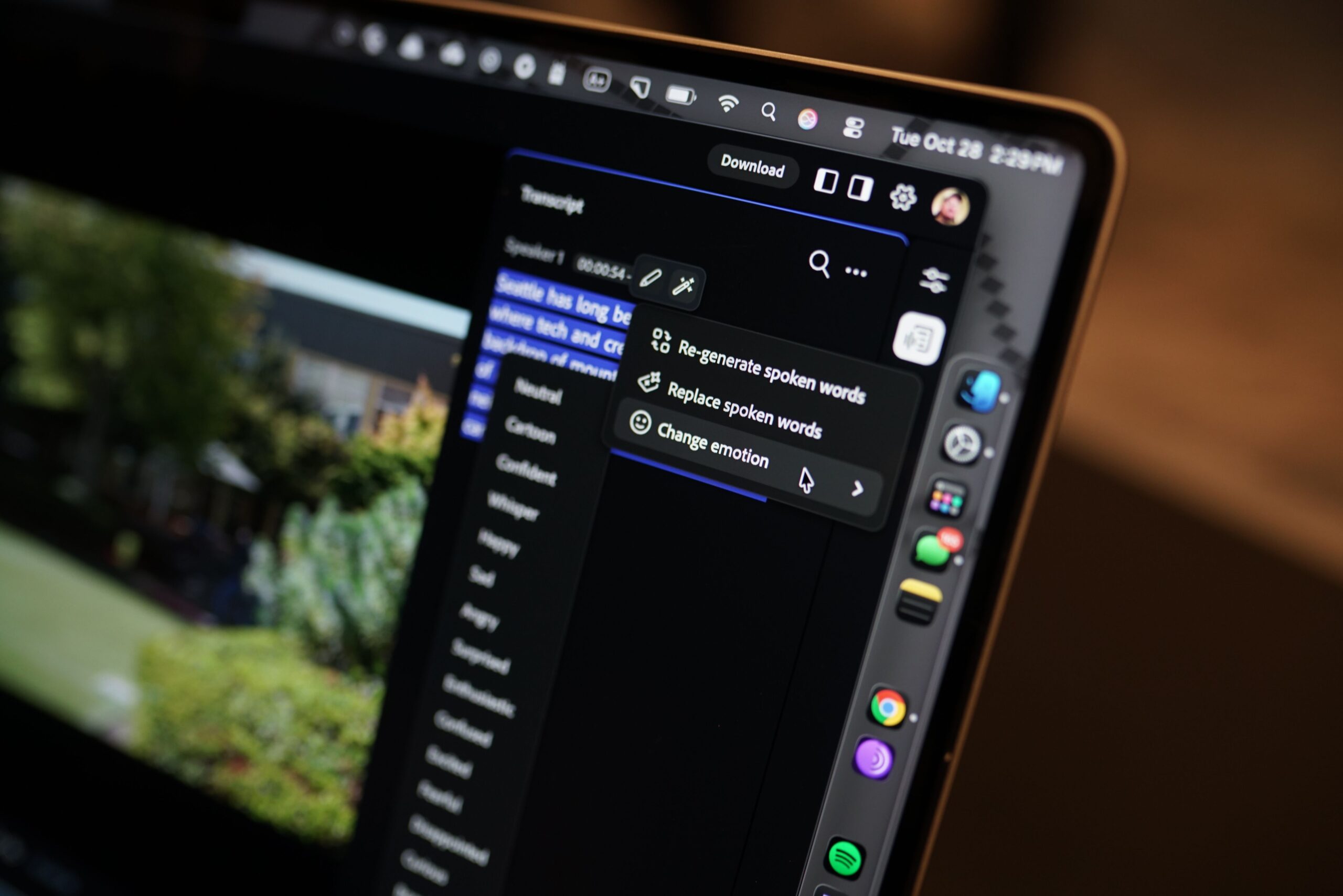All products featured on WIRED are independently selected by our editors. However, we may receive compensation from retailers and/or from purchases of products through these links. Learn more.
Adobe sat me down and played a short demo video with a matter-of-fact, if a bit boring, voice-over. It was nothing special, but after pulling up a transcript, highlighting the text, and choosing from a list of preset emotions, the vocal performance completely changed. It went from flat to confident, then confident to a whisper, all in seconds.
Adobe calls it “Corrective AI,” and it’s one of many features the company will demo later today during its MAX Sneaks showcase, which takes place during the broader annual MAX conference. (Adobe paid for a portion of my travel expenses to attend its MAX conference.) Sneaks is where Adobe shows off future technologies and prototypes it’s working on, and many of these features eventually make their way into Adobe’s full creative suite within a matter of months.
During MAX this year, Adobe released generative speech for Firefly, which allows you to not only use several preset voices but also add emotion tags to change inflection. This Corrective AI feature brings that functionality to a more practical workflow. Rather than use a completely AI-generated voice, you can touch up an existing voice performance.

Photograph: Jacob Roach
Adobe’s Lee Brimelow also showed me how AI can extract different parts of a single audio track to create multiple. The Sneaks prototype, called Project Clean Take, is limited to five tracks, but it can separate voices, ambient noise, sound effects, and more. It was surprising just how accurately the AI model was able to separate the tracks. In one example, Adobe showed me someone speaking in front of a drawbridge, with the sound of the drawbridge bell completely overtaking the voice of the host. After running the AI model, the sound of the bell was gone. Even better, Adobe showed me how you could bring it back by individually adjusting the levels of these split-up tracks.
In another example, Adobe demoed how this could be useful when a creator is shooting in public, particularly when licensed music is playing in the background. It’s no secret that unlicensed music is a quick route to a copyright strike through the automated systems on platforms like YouTube. In the demo, Adobe’s AI model was able to separate the music, replace it with a similar track from Adobe Stock, and apply effects to give it the reverb and ambiance of the original track, all with a few clicks.
These features leverage AI to fix day-to-day problems for video editors and creators, helping restore broken audio or save the time and hassle of re-recording a vocal performance. Adobe will show off new generative AI features during its Sneaks showcase, too. For sound designers, the company showed me how its AI model can automatically analyze and add sound effects to a video, all of which it claims are AI-generated yet commercially safe to use.

Photograph: Jacob Roach
Adobe’s Oriol Nieto loaded up a short video with a handful of scenes and a voice-over, but no sound effects. The AI model analyzed the video and broke it down into scenes, applying emotional tags and a description of each scene. Then, the sound effects came. The AI model picked up on a scene with an alarm clock, for instance, and automatically created a sound effect. It identified a scene where the main character (an octopus, in this case) was driving a car, and it added a sound effect of a door closing.
It wasn’t perfect. The alarm sound wasn’t realistic, and in a scene where two characters were hugging, the AI model added an unnatural rustling of clothes that didn’t work. Instead of manually editing, Adobe used a conversational interface (like ChatGPT) to describe changes. In the car scene, there was no ambient sound from the car. Rather than manually selecting the scene, Adobe used the conversational interface and asked the AI model to add a car sound effect to the scene. It successfully found the scene, generated the sound effect, and placed it perfectly.
These experimental features aren’t available, but they usually work their way into Adobe’s suite. For instance, Harmonize, a feature in Photoshop that automatically places assets with accurate color and lighting in a scene, was shown at Sneaks last year. Now, it’s in Photoshop. Expect them to pop up sometime in 2026.
Adobe’s announcement comes mere months after video game voice actors ended a nearly year-long strike to secure protections around AI—companies are required to get consent and provide disclosure agreements when game developers want to recreate a voice actor’s voice or likeness through AI. Voice actors have been bracing for the impact AI will have on the business for some time now, and Adobe’s new features, even if they’re not generating a voice-over from scratch, are yet another marker of the shift AI is forcing on the creative industry.




